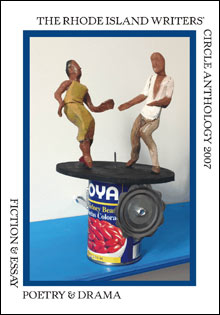Worthy wordsThe Rhode Island Writers’ Circle Anthology February 20,
2007 6:07:40 PM

ALL TOGETHER NOW: The 2007 edition.
|
“Writing, at its best, is a lonely life,” an observant novelist once noted. Since its founding in 1993, the Writers’ Circle has been doing something about that. The organization offers workshops, coaxing aspiring and emerging writers out of their garrets to interact and let their work see the light of day.
The Rhode Island Writers’ Circle Anthology — 2007 has just been published by the Providence-based the Poets’ Press, presenting fiction, memoirs, essays, poetry, and playscripts by 40 writers. As the date in the title indicates, there will be an annual anthology from now on. The first one, on the occasion of their 10th anniversary, appeared four years ago and is being reissued on this occasion.
Brief introductory notes to sections on drama, fiction, and poetry are given by Trinity Rep artistic director Curt Columbus, novelist Robert Leuci, and former poet laureate of Rhode Island Tom Chandler. The non-fiction introduction is given by Rose Pearson, the Writers’ Circle founder, creative director, and primary editor of the volume.
The eight fiction pieces range from a 1-1/2-page vignette about a memento mori, Niki Toler’s “Yard Sale,” to lengthy short stories, such as the deft family portrait “Secret Madness,” by Carol A. DiFabio. The latter describes an Easter dinner from the point of view of a nine-year-old girl who gets a chance to sit at the grown-ups’ table. The collective portrait is full of amusing specifics, and even a grandmother’s empty bedroom is described imaginatively, as having “that kind of quiet that whooshes around you, as though a pipe somewhere pulled out all the noises.” In a contrasting setting of corporate Manhattan, Christina Gom¬bar’s “The Black Box” traces the footsteps of a potential office romance/dalli¬ance/betrayal, providing subtle psychological suspense rather than a more facile, plot-oriented arc.
The stories are all in the tradition of literary realism, going for Cheever rather than Coover. For metafiction, head for the drama section and the longest of the three plays there, Pearson’s HeShe. There’s a reason that we don’t see more playscripts in literary journals: it takes much more than words to bring them to life. In this one, long passages of poetic language are framed by two actors speaking conversationally, and what might be made lyrical on stage reads as precious on the page.
Again in the realistic mode, the poetry here tends to go for clarity while not neglecting insight. For example, two poems by Louise Giguere take on the difficult matter of solidifying abstractions; “Matthew’s Meaning” conveys the spirit and intelligence of someone who is probably a child but who is further respected by not being specifically identified as such. Brett Rutherford’s “Tillie” describes a bag lady recalled from childhood, ending with an inspired burst of magic realism:
On side streets,
her shadow shambles without her,
frail as a moth wing,
picked apart by moonlight,
scattered by cicadas,
waiting to reassemble
if she returns
to her appointed rounds.
The nonfiction entries oddly begin with a short piece of creative writing. Gary E. Blais’s “The Watchman’s Blessing” assesses the point of view of an apparent Alzheimer’s victim, a fictional exercise whether or not the person exists. But this section has some excellent first-person accounts. Leith C. MacArthur’s “My First Mountain” is a gripping narrative of a hiking jaunt gone wrong, vividly described and skillfully structured. Niki Toler’s “Learning About Limbo” is also strengthened by an introductory flashback that helps frame and provide suspense for another sort of adventure: surviving cancer. Cuban-American sculptor Ana Flores, who did the anthology’s cover, relates how an object can acquire sacred meaning in “The Statue of the Madonna.”
The novelist who made the opening comment about the friendlessness of writing was Ernest Hemingway. He went on to note: “Organizations for writers palliate the writer’s loneliness, but I doubt if they improve his writing.” With defiant optimism, the Writers’ Circle is soldiering on. (A website is under construction at www.thewriterscircle.org. For information about fiction and non-fiction workshops, which are given every three months, call 401.461.6691.)
|
 |

|
- In The Edge of Disaster, a security expert warns that the US is not prepared for future disasters
- Never mind its tough-girl alt-porn feminism: SuicideGirls has already moved on to a new generation
- Lesson One: the perils of sharing
- Oral is the new second base, the “mostly” girls keep on kissing girls, and the Bro Job has arrived (but is still not ready for its close-up)
- How one little post-war doughnut shop became synonymous with Boston’s identity
- Few on Deval Patrick's ‘fresh blood’ staff have been seasoned in the State-house hallways
- How one little post-war doughnut shop became synonymous with Boston’s identity
- Who’s looking at you, kid?
- SexyFront
- Last year’s New Times–Village Voice media merger pitted two kinds of journalism against each other. Guess who won?
- The abiding lessons of civil-rights-movement-era journalism
- Veteran New York editor Lance Gould to helm the weekly
|
-
Brown's Pulp Uncovered festival
-
Detritus and Crenca's energetic collaboration
-
Trinity Rep's splendid A Delicate Balance
-
Housing crunch
-
Perishable’s probing Constitutional
-
Viva las ropas viejas
-
2nd Story’s madcap Flea In Her Ear
-
Providence Black Rep’s Black Maria
-
Brews, ballgames, and much more
|
- Vikram Chandra’s sprawling, dirty old town
- Roddy Doyle’s heroine recovers
- Mailer takes on young Adolf
- Ron McLarty’s recent novels draw on his hometown of East Providence
- Martin Amis’s Soviet sojourn
- Neal Pollack raises a young ’un
- Kate Atkinson’s fear of genre
- A lawyer’s story of John Cooke
- Thomas Pynchon’s up Against the Day
- Down by law
|
|